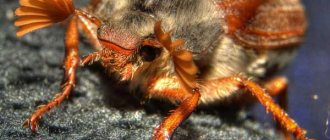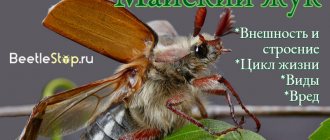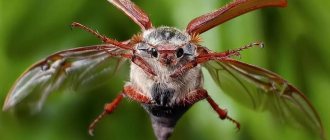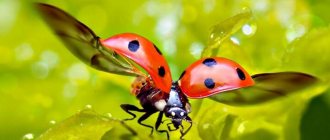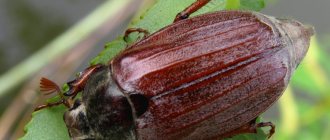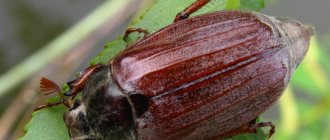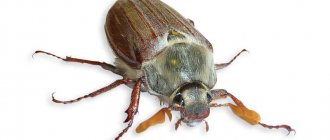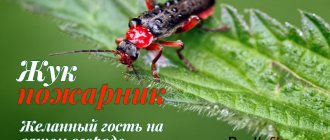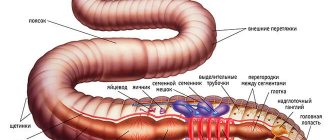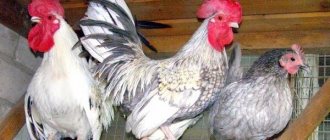May beetles or May beetles (Melolontha hippocastani) belong to the phylum Arthropods, class Insects, genus Melolontha.
This genus consists of 24 species, 9 of which live on the territory of the Russian Federation. The mass appearance of cockchafers occurs in the spring, most often at the end of April and May. Phenologically, the period of appearance of these beetles coincides with the beginning of oak buds and the mass leafing out of birch trees. If you look closely at the ground on these warm spring days, you can see cockchafers crawling out of it after wintering and flying into the air.
On spring evenings, especially near green, flowering trees, you can often hear them buzzing and see them flying.
Landing on trees, they damage young leaves and flowers, so May beetles cause enormous damage to agriculture and forestry. And during the day you may not notice these beetles on a tree or bush; they sit there, clinging to the branches with their legs.
Appearance of the cockchafer
The body of the cockchafer, like most insects, is covered with a chitinous shell, performing the functions of an external skeleton and protection.
Sizes of the cockchafer
The beetles reach a length of 2 to 3.5 cm.
May beetle coloring
Adult individuals are characterized by color dimorphism, that is, individuals may differ in color from each other.
In general, entomologists distinguish two color varieties (aberrations) of chafer beetles: red with a red pronotum and legs (rex) and black with black pronotum and legs (nigripes). These aberrations are considered to be ecological forms of Mayweed.
Beetles with red coloration mainly live in open places with weak shade, while beetles with black coloration live in shaded places, including under the canopy of not very dense forests. Red beetles are found mainly in the northern regions, and black ones in the southern regions. In the center of the species' range, there are approximately equal proportions of beetles of both varieties.
Habitats
May beetles live in Europe and Asia, mainly inhabiting forest-steppe and forest zones, preferring young pine forests.
Within the city limits, these beetles can often be seen in artificial plantings and near flowering fruit trees and shrubs. On trees or shrubs, the beetles feed and mate, after which the females lay eggs, burrowing into the soil.
Lifestyle and habitat
The beetle lives in Asia, Europe, North America and several islands in Oceania. Most varieties prefer temperate regions, but some are found in the tropics.
The main habitat of the cockchafer is deciduous forests, thickets, and gardens. Insects need not only plants as a source of food, but also loose soil.
This is due to the fact that three of the four stages of the beetle's development cycle take place underground. In addition, both larvae and beetles that hatch in late summer or autumn overwinter here.
The life of the cockchafer is very organized. Insects are most active at night. They spend most of their time searching for food and eating it.
Khrushchev is very peaceful, does not fight with other arthropods and tries to stay away from people.
The structure of the cockchafer
The structure of the May beetle is typical of all beetles.
Body parts of the cockchafer
The body and limbs are divided into segments - segments. The beetle's body consists of three sections: head, thorax, and abdomen. In this case, the chest consists of 3 segments, and the abdomen - of 8.
External structure of the cockchafer
The body is covered with small hair-like scales, the head and pronotum are covered with longer hairs that form longitudinal stripes, the underwings may also be covered with hairs.
Head of a cockchafer
On the head there are antennae that have an elongated 3 segment, and in males they end in a strongly curved club, which consists of 7 identical plates.
The limb of a cockchafer
Walking legs (3 pairs) are located on the chest, so each pair of legs corresponds to one segment of the chest. The limb itself is covered with hairs and consists of movably connected segments, which end in claws, with the help of which insects cling to the bark of trees and foliage. Also, the front legs are quite strong and look like scrapers, since the beetle digs a hole with them when laying eggs.
May beetle wings
Wings are attached to the top of the chest: to the second segment are strong chitinous brown elytra that support the beetle’s body in flight, to the third segment are transparent flying wings. The cockchafer is rather clumsy, flies slowly and heavily.
Structure of the circulatory system
The circulatory system of all arthropods is not closed. That is, the blood is located between the internal organs of the cockchafer, it flows around all the internal tissues, thus delivering useful substances and taking away waste from the internal part of the body. The beetle's blood does not carry oxygen, that is, it does not take part in the respiratory process.
A muscular tube pushes the blood to move, this is the so-called heart of the beetle, it is located along the back above the intestines. The tube pulsates very frequently, thereby providing blood to the head. The heart has valves that prevent blood from flowing back out of the brain. When the tube expands, blood flows from the back through the sides (special openings), where the valves are located. In the body itself, blood circulates according to the front-back pattern, that is, first it passes from the front to the back and, pouring into the heart, again rushes to the head.
Organs of the cockchafer
A well-developed system of sensory organs helps chafers navigate in space. So on the head of the beetle there are organs of touch, smell and vision.
Organs of the cockchafer's head
The organs of smell are the antennae; with their help, the insect searches for food, sometimes flying distances of more than a kilometer. The organs of touch are the palps of the oral appendages. The organs of vision are the compound eyes, which are located on the sides of the head. Such eyes consist of thousands of simple eyes and make it possible to see everything that happens around.
The nervous system controls such complex processes of perception and, in general, the work of the entire organism. The central nervous system consists of the brain, the ventral nerve cord, which runs along the ventral side of the body, and the peripharyngeal ganglion.
The brain consists of three sections. The peripharyngeal ganglion is well developed. Almost all of these sections secrete neurosecrets that are responsible for the growth and development of the cockchafer.
What does the cockchafer eat?
Beetles feed on solid plant food, so the oral apparatus and digestive system as a whole are adapted to such nutrition. The cockchafer's digestive system begins with its mouth, which is located on the underside of its head.
The oral apparatus is of a gnawing type, so the bitten food is crushed with the help of the upper and lower jaws and falls into the pharynx, then into the long esophagus. The esophagus has an extension - the goiter, from which food enters the chewing stomach.
Here, food is finally ground with the help of hard chitinous plates and enters the digestive stomach (midgut), where, under the influence of digestive juices, it is digested and absorbed.
Food that is not digested goes into the hindgut, which ends at the anus. It is located at the end of the abdomen. Also in the process of choosing food, movable oral appendages - palps - take part, with the help of which May beetles feel and bring food to the mouth. Without these appendages, the animal will not be able to feed and will die.
The cockchafer has a trachea
Beetles breathe atmospheric oxygen, which enters a system of spiracles (18 pieces) located on the chest and abdomen of the insect. Next, from the spiracles, oxygen enters the thinnest respiratory tubes - the trachea, they envelop the organs, and oxygen freely flows to them.
Circulatory system
The circulatory system of the cockchafer is not closed and has a rather primitive structure, since it only carries nutrients.
The heart has the shape of a tube, which is divided into septa with valve openings, located on the dorsal side of the body. The muscles attached to them extend from the chambers to the sides, contracting, they drive the hemolymph into a long blood vessel - the aorta.
From the aorta, hemolymph flows into the spaces between the organs and fills them. Then the hemolymph is collected again in the heart through the chambers. Hemolymph is colorless, contains phagocytes and special blood cells, its main function is to transport nutrients to organs and tissues, as well as transport metabolic products to the organs.
Excretory organs
The functions of the excretory organs in the cockchafer are performed by the Malpighian vessels, which are thin, blindly closed tubes at the free end. They arise from the alimentary canal between the midgut and hindgut.
From the hemolymph, metabolic products enter the hindgut, from where they are excreted through the anus. The fat body also plays an important role in removing metabolic products from the body; round nodules of uric acid are deposited in it. The fat body is a “storage bud” because uric acid is not excreted from it.
Genitals
May beetles are dioecious insects and reproduce only sexually. The eggs in females are located in the ovaries, which are thin-walled tubes.
The testes of males are convoluted tubes that contain seminal fluid. A short time after mating, the male cockchafers die, and the females lay eggs, burying their eggs in the soil to a depth of 30 cm. Having laid the eggs, the female dies; the clutch contains on average up to 70 eggs.
Digestive system
What does the cockchafer eat? With the help of the sharp ends of the upper jaw, it gnaws the leaf piece by piece, and with the lower jaws, with jagged edges, it grinds everything. Therefore, this jaw structure is defined as gnawing. Everything that the beetle swallows goes into the gastric section, which, in turn, is equipped with chitinous teeth; they grind the food and send it to the intestines, where the process of final digestion takes place. In the intestines, food is absorbed, and the remaining part is excreted through the anus - the anus.
It is interesting to observe the evolutionary change in the oral cavity of insects - those who need to absorb food in a liquid state have developed a proboscis with which they draw it into themselves.
May beetle larva
After a month or a month and a half, the eggs hatch into larvae that live in the soil for 3-4 years. Outwardly, they look like worms, move well in the soil, and are white in color.
Due to the fact that they live underground they have no eyes. The oral apparatus of the gnawing type is well developed, thanks to which the larva of the cockchafer digs the ground and feeds on plant debris and plant roots.
In the first year of life, having a still imperfect oral apparatus, the larva feeds on plant debris. And in the second and third years it can already gnaw through quite powerful roots and rhizomes of plants.
General characteristics of the beetle order and its most important representatives
Beetles are one of the largest orders of insects, numbering about 250,000 species, of which 20,000 species are common in the USSR.
The name of the order reflects the most important feature of beetles: their front wings have turned into hard, durable plates that cover the abdomen and soft hind wings on top, protecting them from damage. Beetles fly using their hind wings, which vibrate to create air thrust like an airplane propeller.
The front wings are retracted to the sides and function like airplane wings, creating lift. At rest, the hind wings fold and hide under the front wings.
The entire body of the beetles is covered with a durable chitinous shell. Their eyes, antennae, and legs are well developed. Mouthparts are gnawing.
Beetles are insects with complete metamorphosis. Their larvae live in water, soil, wood, fruiting bodies of mushrooms, animal corpses, openly on plants, etc.
Metamorphosis of the cockchafer
During its life cycle, the larva goes through several molts and at the end of the last year of life in the soil, in the summer, it enters the next stage of development - the pupa.
Externally, the pupa already resembles an adult beetle, but it does not move or grow, has a white color and short wings. While in this stage, under the influence of hormones, the cockchafer metamorphoses - the growth of wings, limbs, and the formation of visual organs. By the end of summer, the pupae turn into full-fledged beetles, but emerge from the ground only in the spring.
Stages of development of the cockchafer
Thus, there are 4 stages of development of the cockchafer: egg, larva, pupa and imago (adult insect).
Reproduction and development
After fertilization, the female cockchafer burrows into the soil and lays eggs there.
Larva
Larvae emerge from the eggs at the end of summer. Neither in appearance nor in their way of life they are at all similar to adult beetles. The thick whitish body of the larva is arched and covered with a soft chitinous cover. More dense yellowish-brown chitinous covering on the large head and three pairs of legs. The wings of the larva are not developed. The spiracles are visible on the sides of the body. In the back of the abdomen, an intestine filled with earth is visible: young larvae feed on humus. In autumn, the larvae go deep into the soil and overwinter. In the spring of next year they rise to the soil surface, where during the summer they eat the roots of herbaceous plants and pine seedlings. The larvae spend the winter again deep in the soil. The following summer (third year of development), the grown larvae eat the roots of bushes and trees.
Doll
Having overwintered for the third time and grown greatly, at the end of spring the larva goes deeper into the soil and, shedding its larval cover, turns into a pupa. It looks like an adult insect. On it you can distinguish a head with mouthparts and antennae, compound eyes, legs folded on the chest of the pupa, and small wings are noticeable. The chitinous cover is quite dense, but uncolored. The pupa can move its abdomen slightly, but is not able to move or feed. This is a resting stage in development. Under the chitinous cover of the pupa, complex changes occur due to the nutrients accumulated by the larva, leading to the development of all organs of the adult insect. By autumn, the skin of the pupa bursts, and an adult beetle emerges from it with soft, colorless covers, which soon harden and acquire a characteristic color.
The beetles remain overwintering in the ground and come to the surface only in the spring of next year.
Fighting the cockchafer
It has been noticed that in populations there are years with a predominant summer, that is, when a massive flight of the cockchafer occurs. Black beetles develop on a five-year cycle, and red beetles develop on a four-year cycle, so there are three or four-year breaks when chafer beetles are practically not found. Harm to agriculture and forestry is caused by both adults and larvae.
How to deal with the cockchafer?
For many years, scientists have been and are developing methods to reduce the number of cockchafers. So in the 50-60s, E. Khober and in the 70s, Ya. P. Tsinovsky and his group sterilized male May beetles with ionizing radiation and released them into nature.
This method made it possible to achieve a sharp reduction (75-100%) in the population size, which contributed to plant protection. But the method has not become widespread due to the need to collect a large number of males at the required time for irradiation.
Fighting cockchafer larvae
Modern summer residents recommend manually collecting and killing adult beetles from plants or destroying the larvae while digging up the soil.
insect wings
» Arthropods » Insect wings
The ability to fly undoubtedly played a key role for insects in the successful exploration of our planet.
It was on this group of animals that nature first tested a fundamentally new method of movement. The conquest of the air became possible thanks to the formation of a special organ - the wing.
The first insects that possessed it appeared about 300,000,000 years ago. Among modern animals, birds and individual mammals also have wings, for example, representatives of the order Chiroptera - bats and fruit bats.
However, it should be understood that the origin of flight organs varies among large taxonomic groups. Unlike other animals, insects did not have to sacrifice limbs or undergo dramatic anatomical changes.
| Among the insects known to us today, representatives of the orders Bessyazhkova, springtail, double-tailed and bristletail have never had wings |
Structure
In general, insects have two pairs of wings: one is on the second thoracic segment, the other on the third.
The wing itself is an outgrowth of the lateral fold of the body and consists of upper and lower layers, between which there is a gap. Through this gap, hemolymph (blood) enters from the body cavity, nourishing the tissues.
The strength of the wing is given by a complex system of tube-like thickenings, or veins, into which nerves and trachea (respiratory organs) extend. The structural features and venation of the wing serve as the most important features for the identification and classification of insects.
| In the reticulate wings there are many transverse veins between the longitudinal veins. This structure is typical for dragonflies and lacewing insects (lacewings, camels, antlions), etc. |
| The movement of the wings occurs due to the contraction of powerful pectoral muscles and has a complex trajectory resembling a figure eight. Some insects are capable of making more than 1000 strokes per second |
Peculiarities
In many insects, pairs of wings vary in shape, size and function.
Often these differences are pronounced. The first pair of wings in beetles, cockroaches, orthoptera and some other insects is transformed into strong elytra that protect the second membranous pair folded underneath them from damage.
For example, like a ladybug.
The front pair of wings of bedbugs is called half-elytra, since two-thirds of its length, starting from the base, has a dense structure, and the remaining third retains a membranous structure. In addition to direct participation in flight, the half-elytra perform an integumentary function.
The wings of Lepidoptera (butterflies), as the name suggests, are covered with scales, which determine the final color and pattern.
Some insects lost their wings a second time, already in the process of evolution. This happened due to the characteristics of the environment, lifestyle and development. As an example, we can name well-known parasites: fleas, lice and lice.
Nutrition
The main source of food for the cockchafer is leaves, flowers and young shoots of plants. Adult insects are not very picky. Many trees suffer from them, including poplar, acacia, linden, rowan, birch, aspen, and elm.
Among fruit trees and shrubs, Khrushchev prefer plum, apple, gooseberry, pear, cherry, and black currant. But there are plants that cockchafers absolutely do not eat. Among them are lilac and ash.
The larvae actively eat plant roots, as well as root crops. When listing what cultivated plants the larvae of cockchafers feed on, it is worth mentioning onions, potatoes, corn, beets, and strawberries.
When can a beetle fly?
Chafer.
The flight of Khrushchev is the subject of study and even special research. In order to fly, according to the laws of physics and aerodynamics, its wing area must be larger in relation to its body weight. This is called the lift coefficient.
In terms of size, the beetle is less than 1, although at least 2 are required for flight, with a weight of 0.9 g. All data suggests that the flight of the beetle is impossible.
Scientists have noticed that the cockchafer can create lift in an unexplored way.
